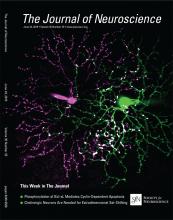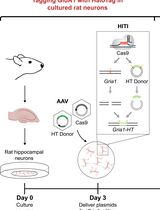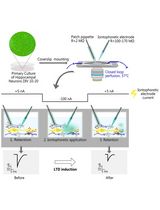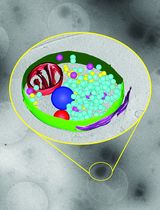- EN - English
- CN - 中文
A Streamlined Method for the Preparation of Gelatin Embedded Brains and Simplified Organization of Sections for Serial Reconstructions
脑组织明胶包埋的最新方法和用以连续重建的切片组织的简化排列
发布: 2017年11月20日第7卷第22期 DOI: 10.21769/BioProtoc.2610 浏览次数: 14002
评审: Shai BerlinJunjie LuoYunbing Ma
Abstract
Gelatin embedding of whole brains for sectioning is a critical procedure used in neuroscience to ensure all morphological and spatial details are preserved intact. Here, we describe an inexpensive, reproducible and efficient means to embed post-fixed brains ready for sectioning in gelatin within a week’s time. The sections obtained are distortion-free and their fragile internal structures preserved which can be used for serial reconstructions for lesion studies and mapping of viral expression after stereotaxic injections. In addition, the separation of adjacent slices into a series of 3-4 vials facilitates subsequent organization and assembly of serial sections at the mounting step.
Keywords: Gelatin embedding (明胶包埋)Background
Recent advances in behavioral neurosciences have allowed the introduction of opsins and antibody targeted-toxins to specific subsets of neurons and regions of the brain. These studies often require visualization of whole brain sections for histological and morphological analysis to localize cell-type specific antibody targeted-toxin induced lesions by stereotaxic injection for behavioral validation (Aoki et al., 2015) or the introduction of virus delivered transgenes (Aquili et al., 2014). Detailed mapping of neuronal circuitry by rabies virus (Suzuki et al., 2012) and localization surveys of serial sections have been achieved using gelatin as an embedding agent, which acts a structural substrate within and around the tissue. Gelatin impregnated brain tissue provides strengthened support for delicate internal structures such as the hippocampus and ventricle spaces which are easily damaged when processed for immunohistochemistry (IHC) and subsequent mounting onto slides. Embedded brain sections are also often free of distortions when mounted and adjacent sections can be used for serial reconstructions.
Qualities of the gel embedding and post-IHC handling are dependent on several procedural details, which can be tedious and time consuming. In previous published protocols, proper penetration and infiltration of the gelatin into the brain and ventricular spaces required a vacuum oven (Griffioen et al., 1992). Further, embedding the brains in a small mold is challenging as the brain has a tendency to float. Additionally, identifying and orienting adjacent slices after IHC processing for serial reconstructions can be arduous.
In this improved protocol, we address several issues important for timely and trouble-free gelatin embedding of whole brains. Begin with rapid impregnation of gelatin into the brain using a magnetic stir bar to weigh the brain down into the liquefied gelatin. Further, the use of an icebox allows the gelatin to set from bottom to top thus eliminating the problem of floating brains. Finally, the arrangement and determination of adjacent serial sections for 3D reconstruction series are simplified by placing the adjacent sections sequentially into 3 to 4 vials, looping back to the first vial after the last. After IHC processing, the sections from each vial are placed in a column next to one another in a large Petri-dish and adjacent slices can be rapidly mounted moving along row by row.
Materials and Reagents
- 50 ml conical tubes in styrofoam frack (Corning, Falcon®, catalog number: 352098 )
- Weigh boats, small and medium (Dyn-A-Med Plus, catalog numbers: 80051 , 80056 )
- 150 mm Petri dishes (Corning, Falcon®, catalog number: 351058 )
- PS-10 vials (AS ONE, catalog number: 9-892-12 )
- Frosted slides (Matsunami Glass, catalog number: S024410 )
- Single edge razors (FEATHER Safety Razor, catalog number: 99129 )
- Paintbrush (Arteje Brush Camlon Pro, model 630 #3/0 Round)
- Kimwipe
- Paraformaldehyde (Merck, catalog number: 104005 )
- Sodium phosphate dibasic (Na2HPO4) (Wako Pure Chemical Industries, catalog number: 197-09705 )
- Sodium phosphate monobasic (NaH2PO4) (Wako Pure Chemical Industries, catalog number: 197-02865 )
- Sucrose (Wako Pure Chemical Industries, catalog number: 190-00013 )
- Gelatin (Wako Pure Chemical Industries, catalog number: 077-03155 )
- H2O2 (Wako Pure Chemical Industries, catalog number: 081-04215 )
- Triton X-100 (Bio-Rad Laboratories, catalog number: 1610407 )
- Tween-20 (Bio-Rad Laboratories, catalog number: 1706531 )
- Anti-tyrosine hydroxylase (Enzo Life Sciences, catalog number: BML-SA497-0100 )
- Thionin (Alfa Aesar, catalog number: A18912 )
- Standard ABC Peroxidase Kit (Vector Laboratories, catalog number: PK-4000 )
- Metal Enhanced DAB Kit (Thermo Fisher Scientific, Thermo ScientificTM, catalog number: 34065 )
- Entellan new mounting medium (Merck, catalog number: 107961 )
- Rabbit Anti-ChAT conjugated saporin (Advanced Targeting Systems, catalog number: IT-42 )
- Mouse Anti-NeuN (Abcam, catalog number: ab104224 )
- Goat Anti-ChAT (EMD Millipore, catalog number: AB144P )
- Biotin conjugated Goat anti-rabbit IgG (Thermo Fisher Scientific, catalog number: B-2770 )
- Biotin conjugated Goat anti-mouse IgG (Thermo Fisher Scientific, catalog number: B-2763 )
- Biotin conjugated Rabbit anti-goat IgG (Thermo Fisher Scientific, catalog number: A10518 )
- 4% PFA/0.1 M PB (4% paraformaldehyde/0.1 M phosphate buffer, pH 7.4) (see Recipes)
- 0.1 M PB (0.1 M phosphate buffer, pH 7.4) (see Recipes)
- 30% sucrose 0.1 M phosphate buffer, pH 7.4 (see Recipes)
- 4% paraformaldehyde/10% sucrose in 0.1 M phosphate buffer, pH 7.4 (see Recipes)
- 0.05 M PB (0.05 M phosphate buffer, pH 7.4) (see Recipes)
- 30% sucrose 0.05 M phosphate buffer, pH 7.4 (see Recipes)
- Blocking solution (see Recipes)
- Antibody solution (see Recipes)
- 0.5% w/v gelatin in H2O (see Recipes)
Equipment
- Rack for 50 ml conical tubes
- Thermometer
- Spoon spatula
- Spin-plus 19 mm magnetic stir-bars (SP Scienceware - Bel-Art Products - H-B Instrument, catalog number: F37144-0034 ) and magnetic spin-bar removal tool
- 2 x 500 ml beakers (DWK Life Sciences, Duran®, catalog number: 21 106 48 )
- 5 L liquid waste buckets for PFA/gel (AS ONE, catalog number: 4-5308-03 )
- Bent forceps (Ideal-Tek, model: 650.S.6 )
- Oven (SANYO, model number: MIR-162 )
- Hot plate with magnetic stirring capability (IKA, model: C-MAG HS 7 )
- Refrigerator (SANYO, model: MPR-414FR )
- Fume hood
- Vibratome (Leica Biosystems, model: Leica VT1000 S )
- Upright light microscope (Olympus, model: CX22LED )
Procedure
文章信息
版权信息
© 2017 The Authors; exclusive licensee Bio-protocol LLC.
如何引用
Readers should cite both the Bio-protocol article and the original research article where this protocol was used:
- Liu, A. W., Aoki, S. and Wickens, J. R. (2017). A Streamlined Method for the Preparation of Gelatin Embedded Brains and Simplified Organization of Sections for Serial Reconstructions. Bio-protocol 7(22): e2610. DOI: 10.21769/BioProtoc.2610.
- Aoki, S., Liu, A. W., Zucca, A., Zucca, S. and Wickens, J. R. (2015). Role of striatal cholinergic interneurons in set-shifting in the rat. J Neurosci 35(25): 9424-9431.
分类
神经科学 > 细胞机理 > 突触生理学
神经科学 > 神经解剖学和神经环路 > 动物模型
细胞生物学 > 细胞成像 > 固定组织成像
您对这篇实验方法有问题吗?
在此处发布您的问题,我们将邀请本文作者来回答。同时,我们会将您的问题发布到Bio-protocol Exchange,以便寻求社区成员的帮助。
提问指南
+ 问题描述
写下详细的问题描述,包括所有有助于他人回答您问题的信息(例如实验过程、条件和相关图像等)。
Share
Bluesky
X
Copy link













